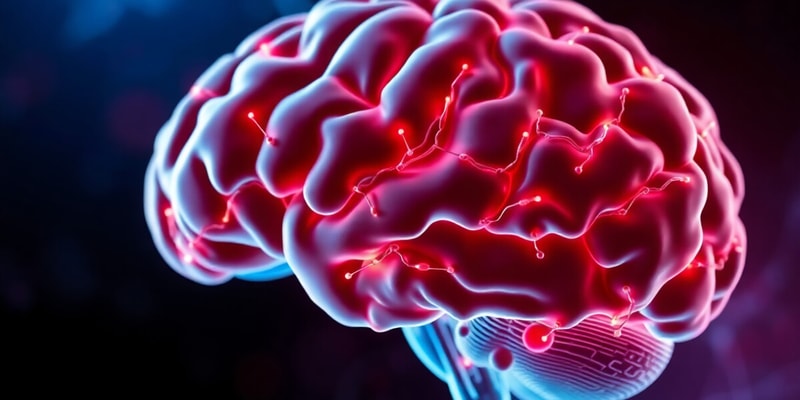Podcast
Questions and Answers
What type of nerve fibers are responsible for the dynamic response in muscle spindles?
What type of nerve fibers are responsible for the dynamic response in muscle spindles?
Which component of the muscle spindle responds to stretch?
Which component of the muscle spindle responds to stretch?
What is the role of gamma motor neurons in muscle spindle function?
What is the role of gamma motor neurons in muscle spindle function?
What does the Golgi tendon organ primarily detect?
What does the Golgi tendon organ primarily detect?
Signup and view all the answers
How are the intrafusal fibers arranged in relation to extrafusal fibers in the muscle spindle?
How are the intrafusal fibers arranged in relation to extrafusal fibers in the muscle spindle?
Signup and view all the answers
Which type of sensory innervation primarily detects the static response of stretch?
Which type of sensory innervation primarily detects the static response of stretch?
Signup and view all the answers
What phenomenon occurs during the co-activation of alpha and gamma motor neurons?
What phenomenon occurs during the co-activation of alpha and gamma motor neurons?
Signup and view all the answers
Which type of intrafusal fiber is mainly associated with type II sensory endings?
Which type of intrafusal fiber is mainly associated with type II sensory endings?
Signup and view all the answers
What is the primary feedback mechanism of the muscle spindle reflex?
What is the primary feedback mechanism of the muscle spindle reflex?
Signup and view all the answers
What happens to the muscle spindle at point 'B' during a reflex contraction?
What happens to the muscle spindle at point 'B' during a reflex contraction?
Signup and view all the answers
Which of the following accurately describes a component of a reflex arc?
Which of the following accurately describes a component of a reflex arc?
Signup and view all the answers
Which of the following correctly outlines the structure of a muscle spindle?
Which of the following correctly outlines the structure of a muscle spindle?
Signup and view all the answers
How are the gamma motor neurones primarily involved in muscle spindle function?
How are the gamma motor neurones primarily involved in muscle spindle function?
Signup and view all the answers
Which type of reflex is exemplified by the knee jerk response?
Which type of reflex is exemplified by the knee jerk response?
Signup and view all the answers
Which of the following statements about autonomic reflexes is correct?
Which of the following statements about autonomic reflexes is correct?
Signup and view all the answers
What role does the afferent nerve play in the reflex arc?
What role does the afferent nerve play in the reflex arc?
Signup and view all the answers
What is the primary response initiated by the stretch reflex?
What is the primary response initiated by the stretch reflex?
Signup and view all the answers
In a reflex arc, what is the function of the effector?
In a reflex arc, what is the function of the effector?
Signup and view all the answers
Which of the following best distinguishes monosynaptic reflexes from polysynaptic reflexes?
Which of the following best distinguishes monosynaptic reflexes from polysynaptic reflexes?
Signup and view all the answers
What role do gamma motor neurons play in the function of muscle spindles?
What role do gamma motor neurons play in the function of muscle spindles?
Signup and view all the answers
What is a primary feature of the Golgi tendon organ (GTO) reflex?
What is a primary feature of the Golgi tendon organ (GTO) reflex?
Signup and view all the answers
What effectively happens during the flexor (withdrawal) reflex?
What effectively happens during the flexor (withdrawal) reflex?
Signup and view all the answers
How do muscle spindles contribute to motor control?
How do muscle spindles contribute to motor control?
Signup and view all the answers
What do Golgi tendon organs primarily respond to?
What do Golgi tendon organs primarily respond to?
Signup and view all the answers
What is the primary purpose of stretch reflexes?
What is the primary purpose of stretch reflexes?
Signup and view all the answers
What distinguishes the GTO reflex from the stretch reflex?
What distinguishes the GTO reflex from the stretch reflex?
Signup and view all the answers
What does flaccid paralysis refer to?
What does flaccid paralysis refer to?
Signup and view all the answers
What is a key characteristic of polysynaptic reflexes?
What is a key characteristic of polysynaptic reflexes?
Signup and view all the answers
Which muscle groups are most affected by muscle spindles and stretch reflexes?
Which muscle groups are most affected by muscle spindles and stretch reflexes?
Signup and view all the answers
Study Notes
Reflexes
- Reflexes are involuntary, stereotyped, and coordinated responses to stimuli, involving an orderly sequence of events called a reflex arc.
- Reflexes can be classified as somatic or autonomic.
- Reflex arcs involve the following components:
- Receptor
- Afferent Nerve (sensory)
- Centre (CNS or Spinal Cord)
- Efferent Nerve (motor)
- Effector
- Response
- Reflexes can be:
- Monosynaptic (e.g., stretch reflex)
- Polysynaptic (e.g., withdrawal reflex)
The Stretch Reflex
- The stretch reflex is a simple reflex, exemplified by the knee jerk reflex.
- When a muscle is stretched, it contracts reflexively.
- This reflex uses negative feedback to maintain muscle length.
The Muscle Spindle
- The muscle spindle is a mechanoreceptor that responds to stretch and length changes in the muscle.
- It consists of intrafusal muscle fibers that lie parallel to extrafusal fibers.
- Intrafusal fibers have both contractile (poles) and non-contractile (centre) regions.
- There are two types of intrafusal fibers: nuclear bag and nuclear chain fibers.
Muscle Spindle Innervation
- Motor innervation: Gamma (γ) motor neurons innervate intrafusal fibers, controlling their contraction.
-
Sensory innervation:
- Primary (annulospiral) nerve endings: Type 1a afferents, detect both the amount of muscle stretch (static response) and the rate of stretching (dynamic response). They are rapidly conducting myelinated neurons.
- Secondary (flower spray) endings: Type II afferents, detect only static response. They are slower conducting myelinated neurons.
Importance of Gamma (γ) Motor Neurons
- Gamma motor neurons are crucial for maintaining spindle sensitivity during muscle contraction.
- When a muscle contracts, the spindle goes slack, reducing its ability to detect length changes.
- Gamma motor neurons co-activate with alpha motor neurons, contracting intrafusal fibers to keep the spindle "loaded" despite muscle contraction, ensuring ongoing length feedback.
Golgi Tendon Organ (GTO) Reflex
- Location: At the junction of the tendon and muscle.
- Function: Detects muscle tension.
- Structure: Nerve terminals innervate collagen fibers in the tendon.
- Sensory information: Transmitted via Ib afferents (large diameter, rapidly conducting fibers).
- Action: When tension becomes excessive, GTO triggers inhibition of the contracting muscle via an interneuron, leading to reflex relaxation.
- Role: Protects against excessive force in the muscle.
Summary of Muscle Spindle and GTO
- Both provide continuous feedback to the brain about muscle status during contraction.
- Muscle Spindle: Important for maintaining posture, balance, and rapid automatic adjustments in muscle length.
- GTO: Prevents excessive force generation in muscles, contributing to smooth movements.
Flexion (Withdrawal) Reflex
- A protective reflex triggered by painful stimuli, causing rapid withdrawal of a limb.
- Involves divergence of sensory information from the afferent neuron.
- Can also be called the crossed-extensor reflex.
Flaccid Paralysis
- A state of complete muscle relaxation caused by damage to the spinal cord or motor neurons, disrupting the reflex pathways.
Studying That Suits You
Use AI to generate personalized quizzes and flashcards to suit your learning preferences.
Related Documents
Description
This quiz covers the concepts of reflexes, including their classifications, components of the reflex arc, and specifics about the stretch reflex and muscle spindles. Test your understanding of somatic and autonomic reflexes, along with their mechanisms in maintaining muscle function.




